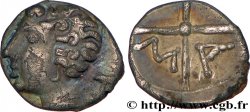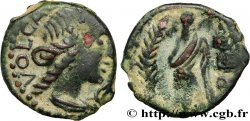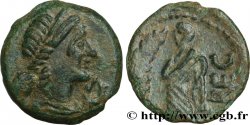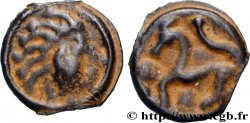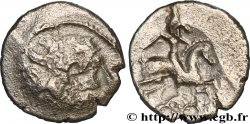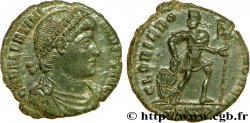bga_412171 - GALLIA - VOLCÆ ARECOMICI (Area of Nîmes) Bronze au cheval, imité des statères arvernes
1 450.00 €
Количество
Добавить в корзину

Тип Bronze au cheval, imité des statères arvernes
Металл: bronze
Диаметр: 18,5 mm
Ориентация осей монеты: 9 h.
Вес: 4,82 g.
Редкость: R3
Комментарии о состоянии
Monnaie très intéressante, avec des types de droit et de revers bien centrés et de frappe vigoureuse. Épaisse patine vert foncé, irrégulière et concrétionnée en surface
Лицевая сторона
Аверс: легенда: ANÉPIGRAPHE.
Аверс: описание: Tête stylisée à gauche, la chevelure en petits traits parallèles, perpendiculaires au crâne; le cou long et mince.
Обратная сторона
Реверс: Описание: Cheval bondissant à gauche, les deux jambes avant pliées et l’arrière train très fin ; une esse au-dessus de la croupe et un objet indéterminé entre les jambes.
Комментарий
Ce type de bronze est exceptionnel ; il s’agit d’une monnaie tardive (en témoigne le style du droit), dont le statère arverne est clairement le prototype. Le type module et le style du revers correspondent aux statère anépigraphe, CAS et VERCINGETORIX avec un revers à l’amphore entre les jambes et à l’esse au-dessus de la croupe. L’amphore semble laisser place à un autre objet tandis que le cheval semble être remplacé par un cheval marin avec un traitement très particulier de l’arrière train.
Deux monnaies de ce type ont été publiées par B. Fischer dans la Revue Archéologique du Centre de la France, Tome 29, fasc. 1, en 1990 “Les relation entre les Arvernes et le Midi méditerranéen à travers la numismatique”. Ces deux monnaies ont été recueillies en fouilles à Nîmes et furent décrite comme étant des “imitation tardives de statère de Vercingétorix”.
This type of bronze is exceptional; it is a late coinage (as evidenced by the style of the law), of which the Arvernian stater is clearly the prototype. The module type and style of the reverse correspond to the anepigraph stater, CAS and VERCINGETORIX with a reverse to the amphora between the legs and to the esse above the rump. The amphora seems to give way to another object while the horse seems to be replaced by a sea horse with very particular treatment of the hindquarters. Two coins of this type were published by B. Fischer in the Revue Archéologique du Center de la France, Volume 29, fasc. 1, in 1990 “The relationship between the Arvernes and the Mediterranean South through numismatics”. These two coins were collected in excavations in Nîmes and were described as “late imitations of Vercingétorix stater”
Deux monnaies de ce type ont été publiées par B. Fischer dans la Revue Archéologique du Centre de la France, Tome 29, fasc. 1, en 1990 “Les relation entre les Arvernes et le Midi méditerranéen à travers la numismatique”. Ces deux monnaies ont été recueillies en fouilles à Nîmes et furent décrite comme étant des “imitation tardives de statère de Vercingétorix”.
This type of bronze is exceptional; it is a late coinage (as evidenced by the style of the law), of which the Arvernian stater is clearly the prototype. The module type and style of the reverse correspond to the anepigraph stater, CAS and VERCINGETORIX with a reverse to the amphora between the legs and to the esse above the rump. The amphora seems to give way to another object while the horse seems to be replaced by a sea horse with very particular treatment of the hindquarters. Two coins of this type were published by B. Fischer in the Revue Archéologique du Center de la France, Volume 29, fasc. 1, in 1990 “The relationship between the Arvernes and the Mediterranean South through numismatics”. These two coins were collected in excavations in Nîmes and were described as “late imitations of Vercingétorix stater”







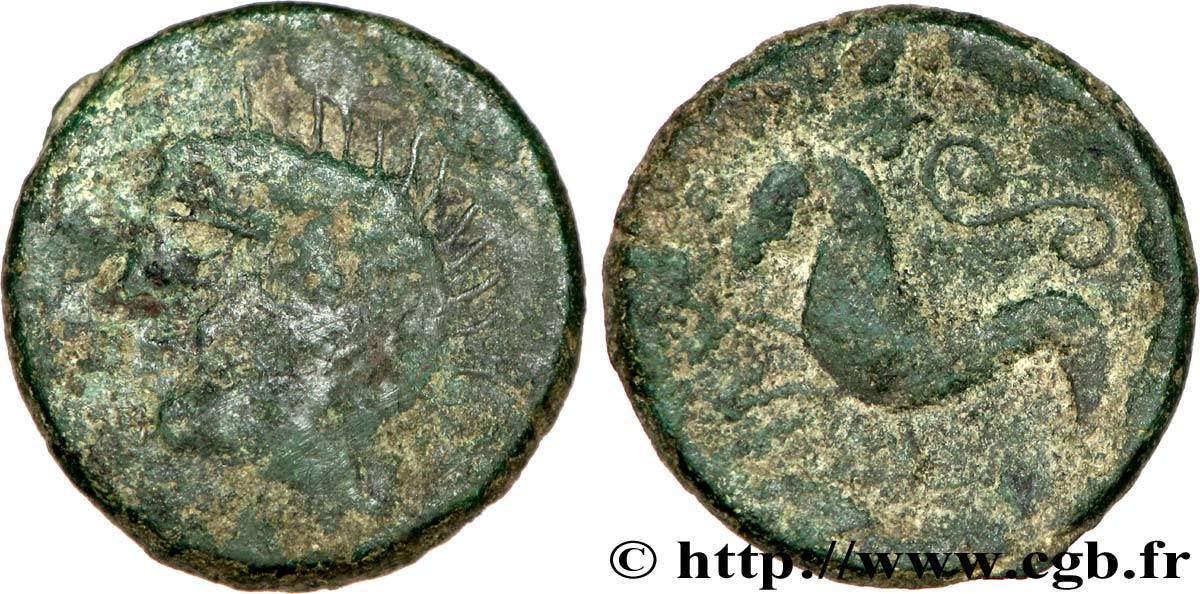
 Cообщить об ошибке
Cообщить об ошибке Распечатать страницу
Распечатать страницу Отправить мой выбор
Отправить мой выбор Задать вопрос
Задать вопрос Consign / sell
Consign / sell
 Информация
Информация
